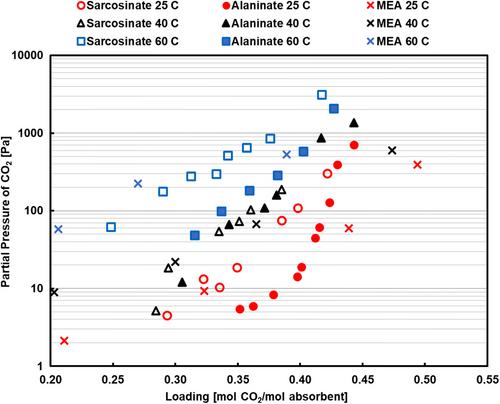Ali Kiani, Will Conway, Mohamed H. Abdellah, Graeme Puxty, Ann-Joelle Minor, Gerard Kluivers, Robert Bennett, Paul Feron
下载PDF
{"title":"用于直接空气捕获的氨基酸水盐的降解和二氧化碳捕获性能研究","authors":"Ali Kiani, Will Conway, Mohamed H. Abdellah, Graeme Puxty, Ann-Joelle Minor, Gerard Kluivers, Robert Bennett, Paul Feron","doi":"10.1002/ghg.2302","DOIUrl":null,"url":null,"abstract":"<p>We have previously proposed amino acid salts solutions as potential absorption liquids for direct air capture (DAC) of CO<sub>2</sub> from the atmosphere. However, little is known about their relevant CO<sub>2</sub> solubilities, CO<sub>2</sub> mass transfer rates, and susceptibility to oxidative and thermal degradation under conditions relevant to DAC. We report here on the overall solubility of CO<sub>2</sub> and CO<sub>2</sub> mass transfer rates into a series of amino acid salts solutions. Additionally, the robustness of various amino acid salt solutions to thermal and oxidative degradation has been assessed.</p><p>CO<sub>2</sub> absorption rates into the amino acid salts solutions were observed to be in the same order of magnitude as aqueous monoethanolamine (MEA), with sarcosinate and lysinate solutions providing the fastest and slowest CO<sub>2</sub> mass transfer rates at 25°C, respectively. Degradation data revealed that all amino acid salt solutions investigated in this study displayed elevated rates of thermal degradation at both 120 and 150°C relative to MEA. The opposite trend was observed with respect to oxidative degradation where all amino acid salt solutions showed a greater resistance to oxidative degradation than that observed for MEA under the conditions investigated here. Considering the degradation, CO<sub>2</sub> absorption capacity, and CO<sub>2</sub> mass transfer rate data, we propose the potassium salts of proline and sarcosine as the most promising amino acid salts (of those considered here) for further evaluation in DAC processes. Overall, this study provides valuable insight into the suitability of various amino acid salt solutions as absorption liquid for DAC. © 2024 The Author(s). <i>Greenhouse Gases: Science and Technology</i> published by Society of Chemical Industry and John Wiley & Sons Ltd.</p>","PeriodicalId":12796,"journal":{"name":"Greenhouse Gases: Science and Technology","volume":"14 5","pages":"859-870"},"PeriodicalIF":2.8000,"publicationDate":"2024-08-16","publicationTypes":"Journal Article","fieldsOfStudy":null,"isOpenAccess":false,"openAccessPdf":"https://onlinelibrary.wiley.com/doi/epdf/10.1002/ghg.2302","citationCount":"0","resultStr":"{\"title\":\"A study on degradation and CO2 capture performance of aqueous amino acid salts for direct air capture applications\",\"authors\":\"Ali Kiani, Will Conway, Mohamed H. Abdellah, Graeme Puxty, Ann-Joelle Minor, Gerard Kluivers, Robert Bennett, Paul Feron\",\"doi\":\"10.1002/ghg.2302\",\"DOIUrl\":null,\"url\":null,\"abstract\":\"<p>We have previously proposed amino acid salts solutions as potential absorption liquids for direct air capture (DAC) of CO<sub>2</sub> from the atmosphere. However, little is known about their relevant CO<sub>2</sub> solubilities, CO<sub>2</sub> mass transfer rates, and susceptibility to oxidative and thermal degradation under conditions relevant to DAC. We report here on the overall solubility of CO<sub>2</sub> and CO<sub>2</sub> mass transfer rates into a series of amino acid salts solutions. Additionally, the robustness of various amino acid salt solutions to thermal and oxidative degradation has been assessed.</p><p>CO<sub>2</sub> absorption rates into the amino acid salts solutions were observed to be in the same order of magnitude as aqueous monoethanolamine (MEA), with sarcosinate and lysinate solutions providing the fastest and slowest CO<sub>2</sub> mass transfer rates at 25°C, respectively. Degradation data revealed that all amino acid salt solutions investigated in this study displayed elevated rates of thermal degradation at both 120 and 150°C relative to MEA. The opposite trend was observed with respect to oxidative degradation where all amino acid salt solutions showed a greater resistance to oxidative degradation than that observed for MEA under the conditions investigated here. Considering the degradation, CO<sub>2</sub> absorption capacity, and CO<sub>2</sub> mass transfer rate data, we propose the potassium salts of proline and sarcosine as the most promising amino acid salts (of those considered here) for further evaluation in DAC processes. Overall, this study provides valuable insight into the suitability of various amino acid salt solutions as absorption liquid for DAC. © 2024 The Author(s). <i>Greenhouse Gases: Science and Technology</i> published by Society of Chemical Industry and John Wiley & Sons Ltd.</p>\",\"PeriodicalId\":12796,\"journal\":{\"name\":\"Greenhouse Gases: Science and Technology\",\"volume\":\"14 5\",\"pages\":\"859-870\"},\"PeriodicalIF\":2.8000,\"publicationDate\":\"2024-08-16\",\"publicationTypes\":\"Journal Article\",\"fieldsOfStudy\":null,\"isOpenAccess\":false,\"openAccessPdf\":\"https://onlinelibrary.wiley.com/doi/epdf/10.1002/ghg.2302\",\"citationCount\":\"0\",\"resultStr\":null,\"platform\":\"Semanticscholar\",\"paperid\":null,\"PeriodicalName\":\"Greenhouse Gases: Science and Technology\",\"FirstCategoryId\":\"93\",\"ListUrlMain\":\"https://scijournals.onlinelibrary.wiley.com/doi/10.1002/ghg.2302\",\"RegionNum\":4,\"RegionCategory\":\"环境科学与生态学\",\"ArticlePicture\":[],\"TitleCN\":null,\"AbstractTextCN\":null,\"PMCID\":null,\"EPubDate\":\"\",\"PubModel\":\"\",\"JCR\":\"Q3\",\"JCRName\":\"ENERGY & FUELS\",\"Score\":null,\"Total\":0}","platform":"Semanticscholar","paperid":null,"PeriodicalName":"Greenhouse Gases: Science and Technology","FirstCategoryId":"93","ListUrlMain":"https://scijournals.onlinelibrary.wiley.com/doi/10.1002/ghg.2302","RegionNum":4,"RegionCategory":"环境科学与生态学","ArticlePicture":[],"TitleCN":null,"AbstractTextCN":null,"PMCID":null,"EPubDate":"","PubModel":"","JCR":"Q3","JCRName":"ENERGY & FUELS","Score":null,"Total":0}
引用次数: 0
引用
批量引用



 求助内容:
求助内容: 应助结果提醒方式:
应助结果提醒方式:


